Abstract
Replacement of starch with raffinose in Duncan and Strong sporulation medium improved percent sporulation in six of eight strains tested. Enterotoxin concentration in cell extracts was increased in the case of four of five known enterotoxin-positive strains. With strain NCTC 10240, levels of 0.3, 0.4, and 0.5% raffinose produced the highest enterotoxin concentration 300 to 320 micrograms of enterotoxin per mg of cell extract protein. At a level of 0.4% raffinose the highest enterotoxin concentration in cell extracts of NCTC 10240 occurred after 8 h of growth in Duncan and Strong medium. Enterotoxin produced in the presence of starch or raffinose by three separate strains all migrated at similar Rm by polyacrylamide gel electrophoresis.
Full text
PDF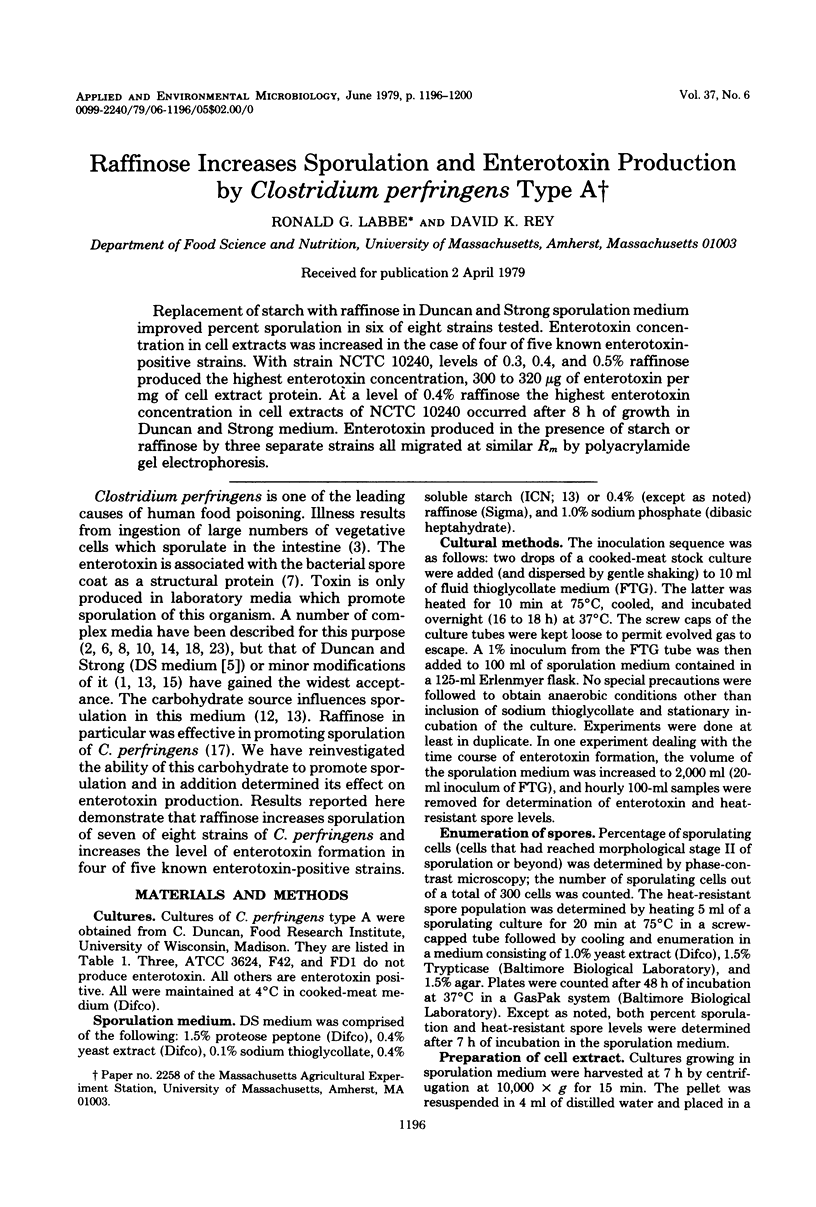
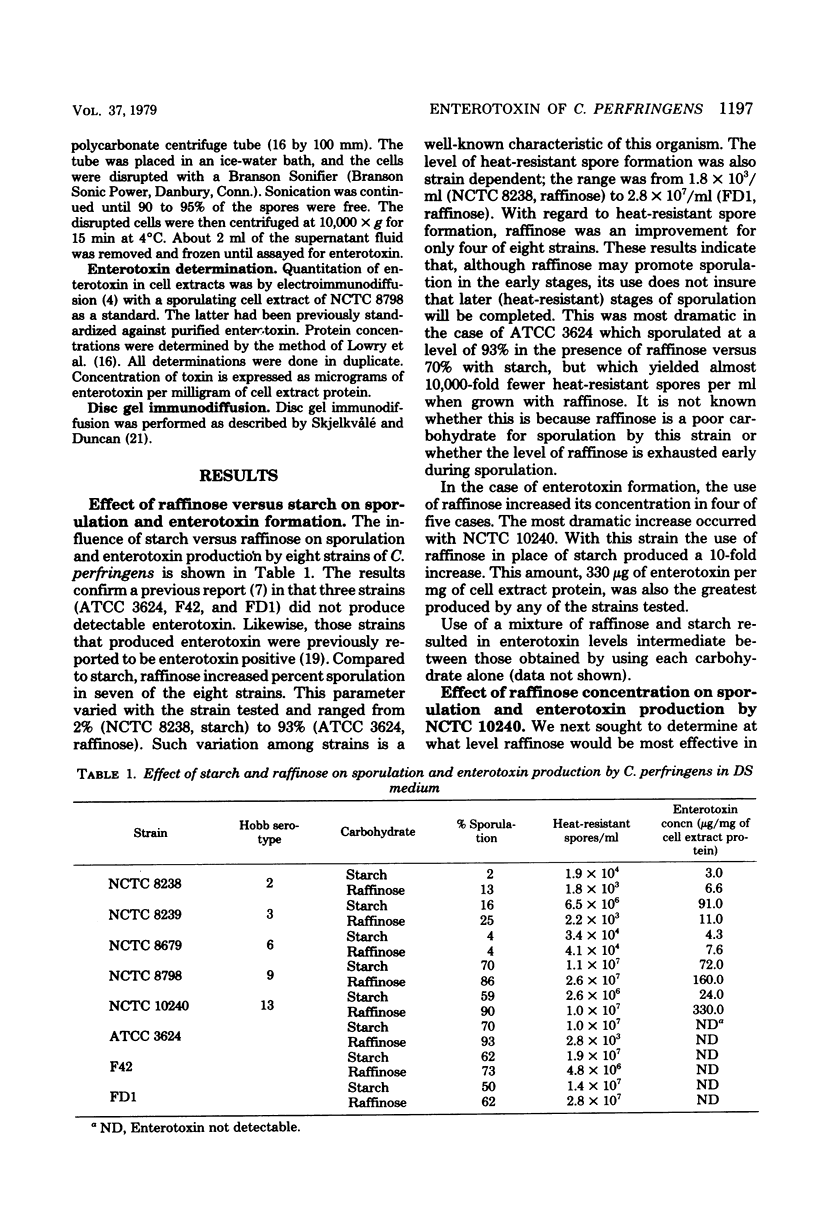
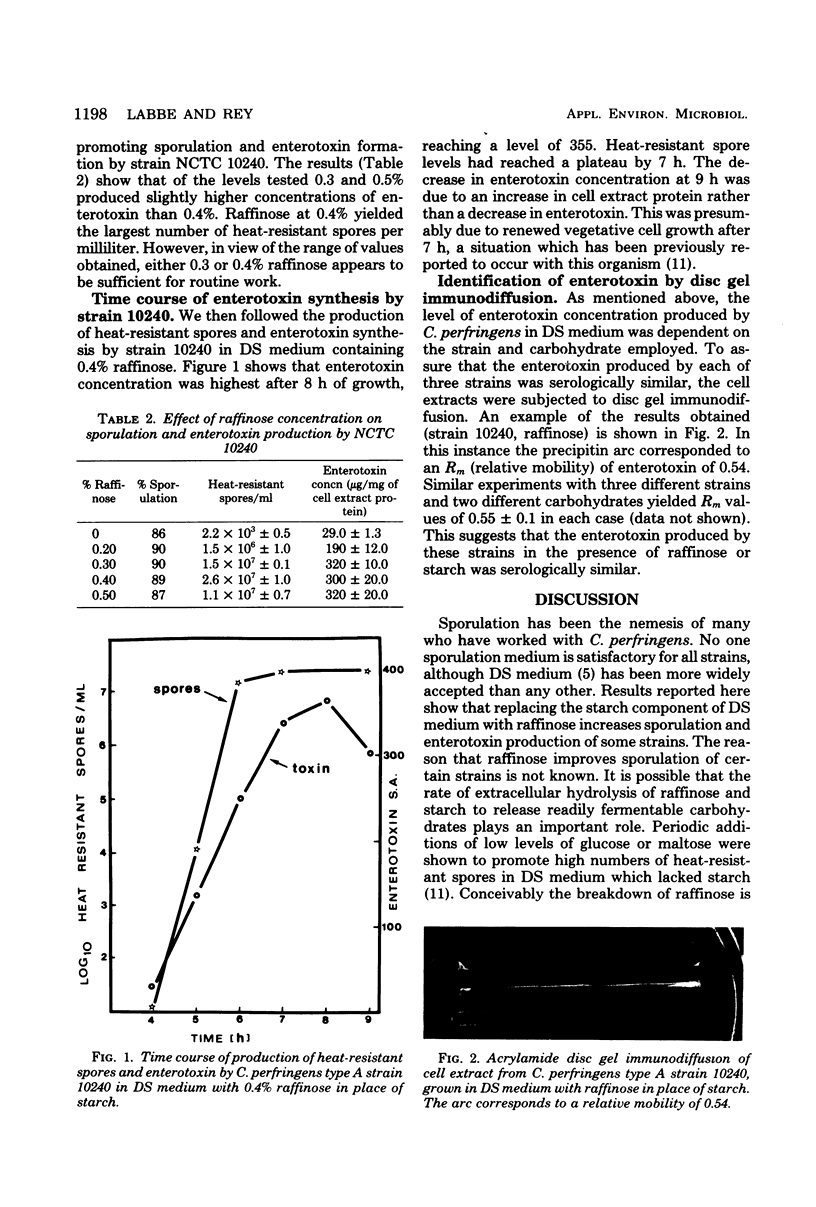
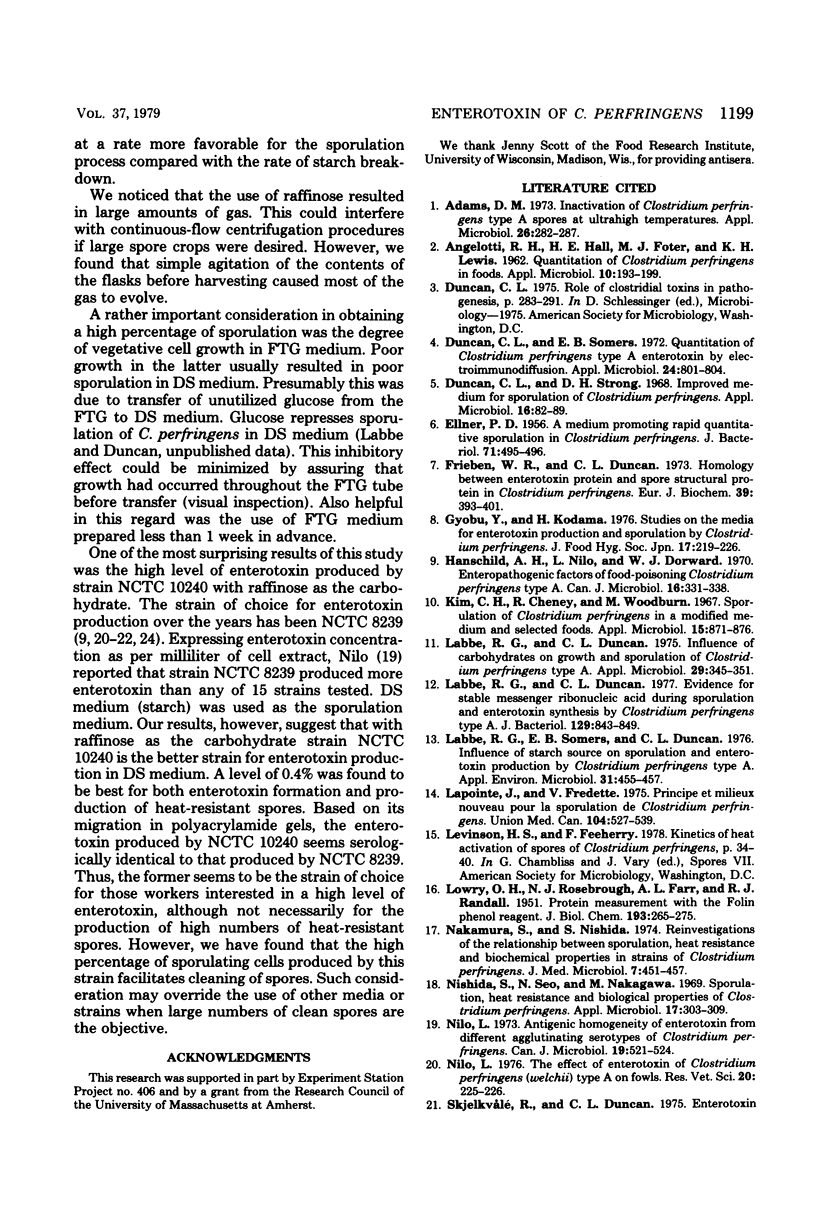
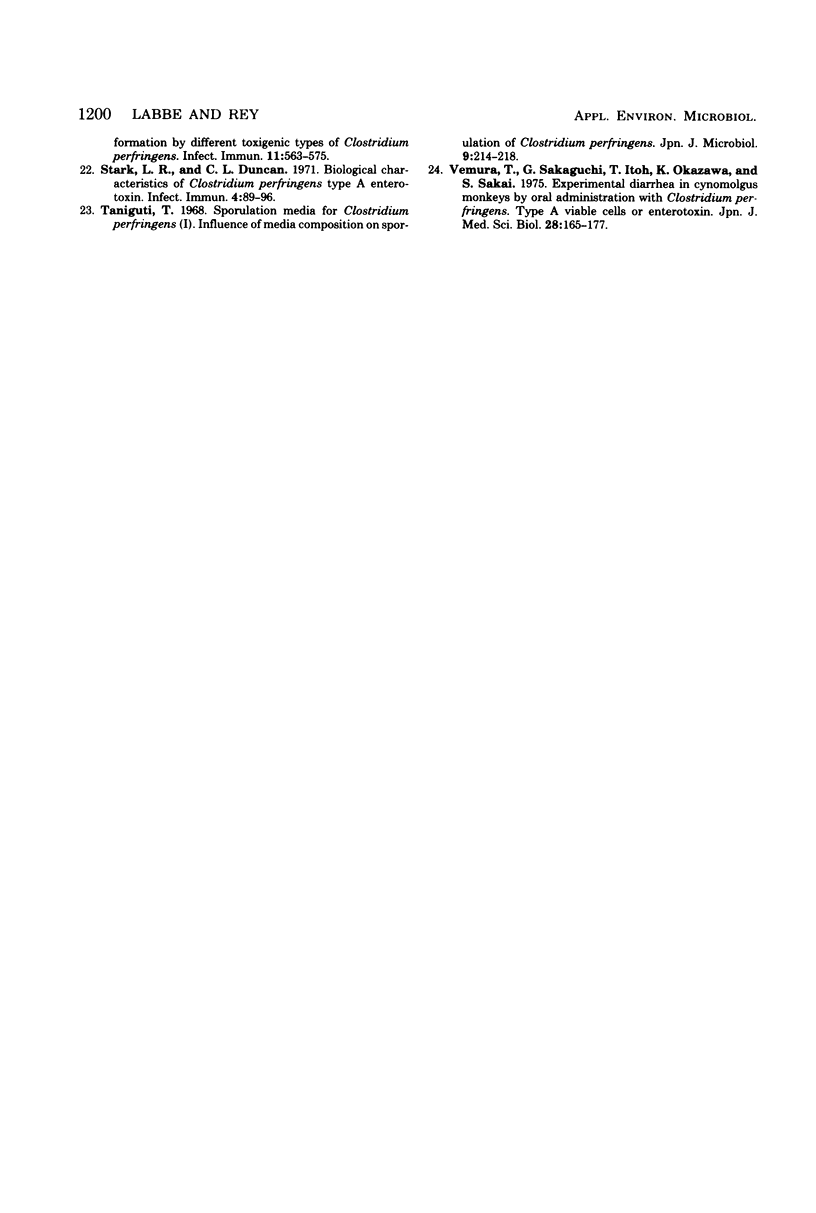
Images in this article
Selected References
These references are in PubMed. This may not be the complete list of references from this article.
- ANGELOTTI R., HALL H. E., FOTER M. J., LEWIS K. H. Quantitation of Clostridium perfringens in foods. Appl Microbiol. 1962 May;10:193–199. doi: 10.1128/am.10.3.193-199.1962. [DOI] [PMC free article] [PubMed] [Google Scholar]
- Adams D. M. Inactivation of Clostridium perfringens type A spores at ultrahigh temperatures. Appl Microbiol. 1973 Sep;26(3):282–287. doi: 10.1128/am.26.3.282-287.1973. [DOI] [PMC free article] [PubMed] [Google Scholar]
- Duncan C. L., Somers E. B. Quantitation of Clostridium perfringens type A enterotoxin by electroimmunodiffusion. Appl Microbiol. 1972 Nov;24(5):801–804. doi: 10.1128/am.24.5.801-804.1972. [DOI] [PMC free article] [PubMed] [Google Scholar]
- Duncan C. L., Strong D. H. Improved medium for sporulation of Clostridium perfringens. Appl Microbiol. 1968 Jan;16(1):82–89. doi: 10.1128/am.16.1.82-89.1968. [DOI] [PMC free article] [PubMed] [Google Scholar]
- ELLNER P. D. A medium promoting rapid quantitative sporulation in Clostridium perfringens. J Bacteriol. 1956 Apr;71(4):495–496. doi: 10.1128/jb.71.4.495-496.1956. [DOI] [PMC free article] [PubMed] [Google Scholar]
- Frieben W. R., Duncan C. L. Homology between enterotoxin protein and spore structural protein in Clostridium perfringens type A. Eur J Biochem. 1973 Nov 15;39(2):393–401. doi: 10.1111/j.1432-1033.1973.tb03137.x. [DOI] [PubMed] [Google Scholar]
- Hauschild A. H., Niilo L., Dorward W. J. Enteropathogenic factors of food-poisoning Clostridium perfringens type A. Can J Microbiol. 1970 May;16(5):331–338. doi: 10.1139/m70-059. [DOI] [PubMed] [Google Scholar]
- Kim C. H., Cheney R., Woodburn M. Sporulation of Clostridium perfringens in a modified medium and selected foods. Appl Microbiol. 1967 Jul;15(4):871–876. doi: 10.1128/am.15.4.871-876.1967. [DOI] [PMC free article] [PubMed] [Google Scholar]
- LOWRY O. H., ROSEBROUGH N. J., FARR A. L., RANDALL R. J. Protein measurement with the Folin phenol reagent. J Biol Chem. 1951 Nov;193(1):265–275. [PubMed] [Google Scholar]
- Labbe R. G., Duncan C. L. Evidence for stable messenger ribonucleic acid during sporulation and enterotoxin synthesis by Clostridium perfringens type A. J Bacteriol. 1977 Feb;129(2):843–849. doi: 10.1128/jb.129.2.843-849.1977. [DOI] [PMC free article] [PubMed] [Google Scholar]
- Labbe R. G., Duncan C. L. Influence of carbohydrates on growth and sporulation of Clostridium perfringens type A. Appl Microbiol. 1975 Mar;29(3):345–351. doi: 10.1128/am.29.3.345-351.1975. [DOI] [PMC free article] [PubMed] [Google Scholar]
- Labbe R., Somers E., Duncan C. Influence of starch source on sporulation and enterotoxin production by Clostridium perfringens type A. Appl Environ Microbiol. 1976 Mar;31(3):455–457. doi: 10.1128/aem.31.3.455-457.1976. [DOI] [PMC free article] [PubMed] [Google Scholar]
- Lapointe J. R., Fredette V. Principe et milieux nouveaux pour la sporulation de clostridium perfringens. Premiers résultats avec un mutant atténué. Union Med Can. 1975 Apr;104(4):527–538. [PubMed] [Google Scholar]
- Nakamura S., Nishida S. Reinvestigations of the relationship between sporulation, heat resistance and some biochemical properties in strains of Clostridium perfringens. J Med Microbiol. 1974 Nov;7(4):451–457. doi: 10.1099/00222615-7-4-451. [DOI] [PubMed] [Google Scholar]
- Niilo L. Antigenic homogeneity of enterotoxin from different agglutinating serotypes of Clostridium perfringens. Can J Microbiol. 1973 Apr;19(4):521–524. doi: 10.1139/m73-083. [DOI] [PubMed] [Google Scholar]
- Niilo L. The effect of enterotoxin of Clostridium welchii (perfringens) type A on fowls. Res Vet Sci. 1976 Mar;20(2):225–226. [PubMed] [Google Scholar]
- Nishida S., Seo N., Nakagawa M. Sporulation, heat resistance, and biological properties of Clostridium perfringens. Appl Microbiol. 1969 Feb;17(2):303–309. doi: 10.1128/am.17.2.303-309.1969. [DOI] [PMC free article] [PubMed] [Google Scholar]
- Skjelkvålé R., Duncan C. L. Enterotoxin formation by different toxigenic types of Clostridium perfringens. Infect Immun. 1975 Mar;11(3):563–575. doi: 10.1128/iai.11.3.563-575.1975. [DOI] [PMC free article] [PubMed] [Google Scholar]
- Stark R. L., Duncan C. L. Biological characteristics of Clostridium perfringens type A enterotoxin. Infect Immun. 1971 Aug;4(2):89–96. doi: 10.1128/iai.4.2.89-96.1971. [DOI] [PMC free article] [PubMed] [Google Scholar]
- Uemura T., Sakaguchi G., Ito T., Okazawa K., Sakai S. Experimental diarrhea in cynomolgus monkeys by oral administration with Clostridium perfringens type A viable cells or enterotoxin. Jpn J Med Sci Biol. 1975 Jun;28(3):165–177. doi: 10.7883/yoken1952.28.165. [DOI] [PubMed] [Google Scholar]



